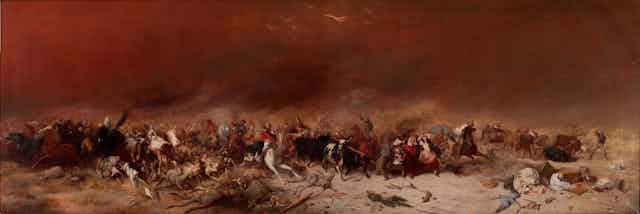The bushfires that have recently ravaged Western Australia and Tasmania have destroyed lives, property and heritage landscape. Bushfires loom large in the Australian national identity, but they are not purely destructive, and can frequently lead to new life.
Paul Nash’s 1918 painting We Are Making a New World, below, offers an arresting vision of ecological vandalism. Representing the devastation to the landscape caused by European trench warfare during the first world war, Nash shows row upon row of dead trees.
This vision points to the war’s environmental cost, while at the same time the trees stand in for the millions of human lives lost in battle.
Conventionally, Nash’s “new world” is seen as one of bleak destruction, but when my colleague, Katherine Firth, shared this work with a group of Australian students, they viewed the painting in a different light.
In a northern-hemisphere context, Nash’s blackened trees are almost signifiers of the apocalypse, with the shell-torn land around them compounding their deadness. This is a world of despair, in which death reigns supreme.

This painting spoke differently to the Australian students, accustomed as they were to images of bushfire-ravaged forests, often sprouting with the greenery of regrowth just months after appearing blackened and dead.
The students saw hope in Nash’s deathly symbolism, interpreting the battleground as a site of renewal and leaping forward with their imaginations to think about how the land might appear, rejuvenated in the near future.
Drama and energy
The fire-torn forest has a central place in the art and literature of the Australian settler community. Bushfires add drama to plots, while adding a touch of exoticism for the non-Australian reader.
Visually, the bushfire is compelling because of its sheer scale, but also as a result of its many vivid colours. Paintings such as William Strutt’s extraordinary Black Thursday (main image), commemorating the Victorian fires of 1851, capture the fire’s destructive energy, while also conveying the terror of those caught in its path.
Works such as Tom Roberts’ painting The South Wind, below, tell another story, moving beyond the immediacy of the insatiable flames to consider a bushfire’s aftermath. In placing three ghostly white tree trunks alongside blackened and budding trees, the artist reveals the visually curious juxtaposition of the living and the dead, which is such an uncanny feature of the Australian landscape.

The trees stand in the way of a broader vista, inflecting our vision of the greens and browns of the fields beyond, reminding the viewer of the widespread threat that fire poses, while at the same time hinting at the land’s almost supernatural capacity to renew itself from the ashes.
Poems including Forest Rambles in Tasmania, an anonymous work published in the Tasmanian Mail in September 1879, move through the terror of the fire’s onslaught, to an understanding that time – and rain – will see “the forest rise again”.
New levels of destruction
It’s well known that many aspects of Australian ecology depend upon fire and, as the historian Tom Griffiths reminds us, trees like the mountain ash depend upon periodic burning to release their seeds.

The burning of the land – whether naturally or through human agency – has long been an emotional matter, but as the environmental historian Stephen Pyne pointed out in his 2012 interview with Motherboard, the fires we are seeing now are the “fires of regime change”, with their growing frequency and intensity resulting from the impact of European farming methods and other forms of human-induced climate change upon the environment.
The recent blazes in the Tarkine Wilderness and Tasmania’s World Heritage Area highlight the damage that this new world of fire is causing. Professor David Bowman emphasised the connections between these fires and climate change, noting their severity, and stressing that trees such as the pencil pine and King Billy pine have not evolved to regenerate from the flames.
Expressing the severity of the damage to Tasmania’s unique ecology, Bowman equated the potential extinction of these species with the loss of the thylacine.
Mourning the lost
Bowman’s careful comparison of these trees with the Tasmanian tiger is designed to evoke an emotional response, reminding the public of the great sense of loss and yearning surrounding an animal considered a pest, until it was no more.
A work such as poet Cliff Forshaw’s elegiac Tiger (2011) expresses longing for the extinct species. According to climate change experts, mourning lost flora and fauna will become a regular feature of our future.
In his poem Loop, Forshaw writes of watching footage of one of the last thylacines, the scratchy old film almost bringing the tiger back to life each time it is played.
Yet as the 62 seconds of film end, the poem’s tone becomes bereft and the words “It’s down. It’s out” signal that the tiger’s short-lived resurrection will give way once more to the oblivion of death.

Art and literature have played important roles in the recovery process that follows a fire.
Sometimes fire is equated with a national resilience, aligning the natural regrowth of a charred waste land with a settler tenacity that refuses to bow down in the face of the flames.
Yet these most recent fires signal something different and remind us that we are living in an age of accelerated extinction.
The question that arises is what the role of the arts will be in a world punctuated by the loss of habitats, flora and fauna. Will we fall back upon music, art and literature as outlets for the extreme emotions that such widescale loss will evoke, or will they become media to express commemoration and regret?
As David Bowman has warned, regeneration is becoming a thing of the past, and as such, the image of a burned forest will shift from being an expression of hope to being loaded with a very different set of emotions.

